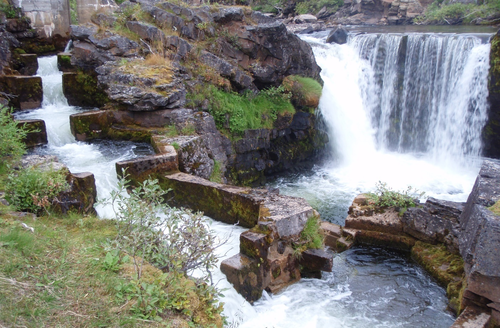Pool-type fishways
Contents
Introduction
Pool-type fishways is today the most common fish passage type in Europe (Silva et al. 2017, Fjeldstad 2012). It consists of pools separated by transverse walls with surface notches or submerged orifices. In addition, vertical slots all the way from the surface to the bottom can be used between the pools This fish passage type is suited for strong swimmers, such as adult salmon and trout, while it often has reduced functionality for other species of fishes and juvenile fish. Benthos usually cannot pass through pool type fishways. Bottom cuts that improve conditions for these species tend to quickly be clogged (DWA 2014) and are usually not suitable for eels and lamprey (Armstrong et al., 2010). Pool type fishways requires stable water discharge to work. One exception is the vertical slot type, which is more flexible for upstream water level and discharge. Adjustable sluice gates can provide stable water flow at varying upstream water levels. This fishway type may be suitable for adult salmon and large trout even when the available terrain is steep.
It is recommended that the pools are at least 1.5 m long for trout and 2.8 m long for salmon (Seifert 2014, DWA 2014), preferably larger. Energy density should be below 200 W/m3. For leap level, max. 50 cm for salmon and trout is recommended. Exceptionally, up to 75 cm can work for adult salmon and sea trout in steep rivers, but then the pool depth should be at least 1.5 m. For resident trout and for grayling, maximum drop between pools should be 20 cm, and for carp fishes 10-15 cm. Ideally, however, one should make vertical slot fishways for these species. The slots should be deeper than the drop height between pools, so that the fish can mainly swim between the pools and are not forced to jump (DWA 2014). For salmon and large trout, the fishway gradient should be between 0.1 and 0.2. For resident trout and carp fish, it should be below 0.1. Coarse or rough bottom substrates in the pools will facilitate migration, but this must always be balanced against reduced volume and water depth.
Methods, tools, and devices
During planning
Planning of a pool-type fishway will start with mapping and surveying of the barrier itself and the river reach upstream and downstream of the barrier, including information about the hydropower scheme. Surveying must also be conducted in the area of the river bank where the fishway is planned, including geological surveying. Geographic data should be handled in GIS software for further planning and analyses. The design of the fishway should be conducted with conventional hydraulic- and civil engineering calculations and drawing. All material used in a fishway must be planned to withstand physical strain from water, floods and frost. Monitoring facilities should basically be planned in the upper part of the fishway.
During implementation
Physical implementation of pool-type fishways requires heavy machinery suited for the river size and its surrounding terrain, such as excavators and lorries. Work with explosives is relevant in most cases and blasted rocks and transportation of material out from the site is common. Surplus rocks should not be disposed at site because of pollution risk. The construction phase includes construction of concrete formwork, casting of concrete and iron reinforcement work. In certain sites, pools are formed in clean rocks.
During operation
Injuries on pool-type fishways from physical wear must be monitored and repaired in order to secure regular fish migration. Maintenance work normally require hand-tools more than heavy equipment, but casting of concrete is typical. Depending of the site, removal of sediment, branches, logs and floating debris in pools and fishway entrance is common. Monitoring systems require regular inspection, depending on product and system.
Relevant MTDs and test cases
Classification table
| Classification | Selection |
|---|---|
| Fish species for the measure | Gravel spawners |
| Does the measure require loss of power production | Operational (requires flow release outside turbine) |
| - | |
| - | |
| Recurrence of maintenance | Irregular at events |
| Which life-stage of fish is measure aimed at | - |
| - | |
| Adult fish | |
| Movements of migration of fish | |
| Which physical parameter is addressed | N/A |
| - | |
| - | |
| - | |
| - | |
| - | |
| - | |
| - | |
| Hydropower type the measure is suitable for | Plant in dam |
| Plant with bypass section | |
| Dam height (m) the measure is suitable for | Up to 50 |
| Section in the regulated system measure is designed for | In dam/power plant |
| - | |
| - | |
| - | |
| River type implemented | Steep gradient (up to 0.4 %) |
| Fairly steep with rocks, boulders (from 0.4 to 0.05 %) | |
| Slow flowing, lowland, sandy (less than 0.05 %) | |
| Level of certainty in effect | Moderately certain |
| Technology readiness level | TRL 9: actual system proven in operational environment |
| Cost of solution | See cost table |
